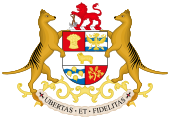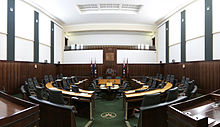Tasmanian Legislative Assembly
| House of Assembly | |
|---|---|
 |
|
| Type | |
| Type | |
| History | |
| Founded | 1856 |
| Leadership | |
|
Chair of Committees
|
|
| Structure | |
| Seats | 25 |
 |
|
|
Political groups
|
Government Liberal (15) Opposition Labor (7) Crossbench Greens (3) |
| Elections | |
|
Last general election
|
15 March 2014 |
|
Next general election
|
by 2018 |
| Meeting place | |
 |
|
| House of Assembly Chamber, Parliament House, Hobart, Tasmania, Australia |
|
| Website | |
| House of Assembly | |
The House of Assembly, or Lower House, is one of the two chambers of the Parliament of Tasmania in Australia. The other is the Legislative Council or Upper House. It sits in Parliament House in the state capital, Hobart.
The Assembly has 25 members, elected for a term of up to four years, with five members being elected in each of five electorates, called divisions. Each division has approximately the same number of electors. Voting for the House of Assembly is by a form of proportional representation using the single transferable vote (STV), known as the Hare-Clark electoral system. By having multiple members for each division, the voting intentions of the electors are more closely represented in the House of Assembly, and a division's minority party usually wins at least one seat. Since 1998, the quota for election in each division, after distribution of preferences, has been 16.7% (one-sixth). Under the preferential proportional voting system in place, the lowest-polling candidates are eliminated, and their votes distributed as preferences to the remaining candidates. If a candidate achieves a quota, their surplus votes are redistributed as preferences. The last election for the House of Assembly took place on 15 March 2014.
This system makes it easier for minor parties to gain election and possibly gain the balance of power. In the present House of Assembly, winning 15 seats—only two more than necessary for a majority—is considered a landslide victory.
Most legislation is initiated in the House of Assembly. The party or coalition with a majority of seats in the House of Assembly is invited by the Governor of Tasmania to form Government. The leader of that party becomes the Premier of Tasmania, and his/her senior colleagues become ministers responsible for various portfolios. As Australian politicians traditionally vote along party lines, most legislation introduced by the governing party will be passed by the House of Assembly.
...
Wikipedia
